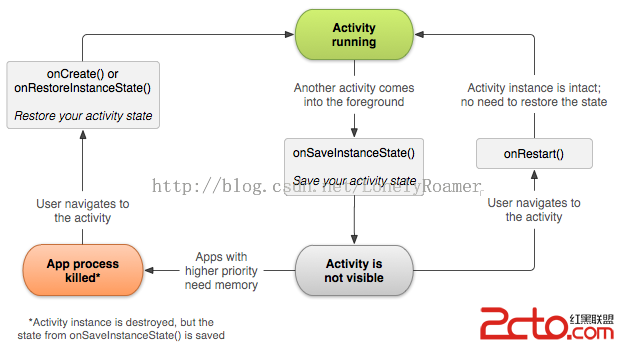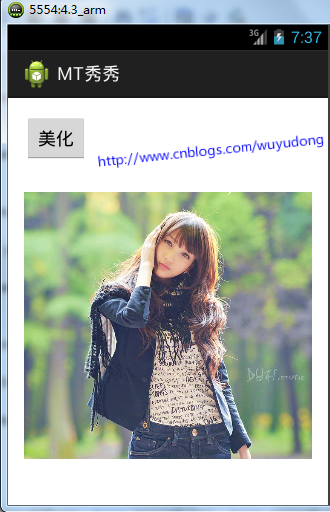轉載:android MVC設計模式,androidmvc
Controller控制器
import android.app.Dialog;
import android.app.ProgressDialog;
- import android.os.Bundle;
- import android.support.v7.app.ActionBarActivity;
- import android.view.View;
- import android.widget.EditText;
- import android.widget.TextView;
- import android.widget.Toast;
- import com.xjp.androidmvcdemo.R;
- import com.xjp.androidmvcdemo.entity.Weather;
- import com.xjp.androidmvcdemo.entity.WeatherInfo;
- import com.xjp.androidmvcdemo.model.OnWeatherListener;
- import com.xjp.androidmvcdemo.model.WeatherModel;
- import com.xjp.androidmvcdemo.model.WeatherModelImpl;
- public class MainActivity extends ActionBarActivity implements OnWeatherListener, View.OnClickListener {
- private WeatherModel weatherModel;
- private Dialog loadingDialog;
- private EditText cityNOInput;
- private TextView city;
- private TextView cityNO;
- private TextView temp;
- private TextView wd;
- private TextView ws;
- private TextView sd;
- private TextView wse;
- private TextView time;
- private TextView njd;
- @Override
- protected void onCreate(Bundle savedInstanceState) {
- super.onCreate(savedInstanceState);
- setContentView(R.layout.activity_main);
- weatherModel = new WeatherModelImpl();
- initView();
- }
- /**
- * 初始化View
- */
- private void initView() {
- cityNOInput = findView(R.id.et_city_no);
- city = findView(R.id.tv_city);
- cityNO = findView(R.id.tv_city_no);
- temp = findView(R.id.tv_temp);
- wd = findView(R.id.tv_WD);
- ws = findView(R.id.tv_WS);
- sd = findView(R.id.tv_SD);
- wse = findView(R.id.tv_WSE);
- time = findView(R.id.tv_time);
- njd = findView(R.id.tv_njd);
- findView(R.id.btn_go).setOnClickListener(this);
- loadingDialog = new ProgressDialog(this);
- loadingDialog.setTitle(加載天氣中...);
- }
- /**
- * 顯示結果
- *
- * @param weather
- */
- public void displayResult(Weather weather) {
- WeatherInfo weatherInfo = weather.getWeatherinfo();
- city.setText(weatherInfo.getCity());
- cityNO.setText(weatherInfo.getCityid());
- temp.setText(weatherInfo.getTemp());
- wd.setText(weatherInfo.getWD());
- ws.setText(weatherInfo.getWS());
- sd.setText(weatherInfo.getSD());
- wse.setText(weatherInfo.getWSE());
- time.setText(weatherInfo.getTime());
- njd.setText(weatherInfo.getNjd());
- }
- /**
- * 隱藏進度對話框
- */
- public void hideLoadingDialog() {
- loadingDialog.dismiss();
- }
- @Override
- public void onClick(View v) {
- switch (v.getId()) {
- case R.id.btn_go:
- loadingDialog.show();
- weatherModel.getWeather(cityNOInput.getText().toString().trim(), this);
- break;
- }
- }
- @Override
- public void onSuccess(Weather weather) {
- hideLoadingDialog();
- displayResult(weather);
- }
- @Override
- public void onError() {
- hideLoadingDialog();
- Toast.makeText(this, 獲取天氣信息失敗, Toast.LENGTH_SHORT).show();
- }
- private <t extends="" view=""> T findView(int id) {
- return (T) findViewById(id);
- }
- }
從上面代碼可以看到,Activity持有了WeatherModel模型的對象,當用戶有點擊Button交互的時候,Activity作為Controller控制層讀取View視圖層EditTextView的數據,然後向Model模型發起數據請求,也就是調用WeatherModel對象的方法 getWeathre()方法。當Model模型處理數據結束後,通過接口OnWeatherListener通知View視圖層數據處理完畢,View視圖層該更新界面UI了。然後View視圖層調用displayResult()方法更新UI。至此,整個MVC框架流程就在Activity中體現出來了。
Model模型
來看看WeatherModelImpl代碼實現
- package com.xjp.androidmvcdemo.model;
-
- /**
- * Description:請求網絡數據接口
- * User: xjp
- * Date: 2015/6/3
- * Time: 15:40
- */
-
- public interface WeatherModel {
- void getWeather(String cityNumber, OnWeatherListener listener);
- }
-
- ................
-
-
- package com.xjp.androidmvcdemo.model;
-
- import com.android.volley.Response;
- import com.android.volley.VolleyError;
- import com.xjp.androidmvcdemo.entity.Weather;
- import com.xjp.androidmvcdemo.volley.VolleyRequest;
-
- /**
- * Description:從網絡獲取天氣信息接口實現
- * User: xjp
- * Date: 2015/6/3
- * Time: 15:40
- */
-
- public class WeatherModelImpl implements WeatherModel {
-
- @Override
- public void getWeather(String cityNumber, final OnWeatherListener listener) {
-
- /*數據層操作*/
- VolleyRequest.newInstance().newGsonRequest(http://www.weather.com.cn/data/sk/ + cityNumber + .html,
- Weather.class, new Response.Listener<weather>() {
- @Override
- public void onResponse(Weather weather) {
- if (weather != null) {
- listener.onSuccess(weather);
- } else {
- listener.onError();
- }
- }
- }, new Response.ErrorListener() {
- @Override
- public void onErrorResponse(VolleyError error) {
- listener.onError();
- }
- });
- }
- }
以上代碼看出,這裡設計了一個WeatherModel模型接口,然後實現了接口WeatherModelImpl類。controller控制器activity調用WeatherModelImpl類中的方法發起網絡請求,然後通過實現OnWeatherListener接口來獲得網絡請求的結果通知View視圖層更新UI 。至此,Activity就將View視圖顯示和Model模型數據處理隔離開了。activity擔當contronller完成了model和view之間的協調作用。
至於這裡為什麼不直接設計成類裡面的一個getWeather()方法直接請求網絡數據?你考慮下這種情況:現在代碼中的網絡請求是使用Volley框架來實現的,如果哪天老板非要你使用Afinal框架實現網絡請求,你怎麼解決問題?難道是修改 getWeather()方法的實現? no no no,這樣修改不僅破壞了以前的代碼,而且還不利於維護, 考慮到以後代碼的擴展和維護性,我們選擇設計接口的方式來解決著一個問題,我們實現另外一個WeatherModelWithAfinalImpl類,繼承自WeatherModel,重寫裡面的方法,這樣不僅保留了以前的WeatherModelImpl類請求網絡方式,還增加了WeatherModelWithAfinalImpl類的請求方式。Activity調用代碼無需要任何修改。
MVC使用總結
利用MVC設計模式,使得這個天氣預報小項目有了很好的可擴展和維護性,當需要改變UI顯示的時候,無需修改Contronller(控制器)Activity的代碼和Model(模型)WeatherModel模型中的業務邏輯代碼,很好的將業務邏輯和界面顯示分離。
在Android項目中,業務邏輯,數據處理等擔任了Model(模型)角色,XML界面顯示等擔任了View(視圖)角色,Activity擔任了Contronller(控制器)角色。contronller(控制器)是一個中間橋梁的作用,通過接口通信來協同 View(視圖)和Model(模型)工作,起到了兩者之間的通信作用。
什麼時候適合使用MVC設計模式?當然一個小的項目且無需頻繁修改需求就不用MVC框架來設計了,那樣反而覺得代碼過度設計,代碼臃腫。一般在大的項目中,且業務邏輯處理復雜,頁面顯示比較多,需要模塊化設計的項目使用MVC就有足夠的優勢了。
4.在MVC模式中我們發現,其實控制器Activity主要是起到解耦作用,將View視圖和Model模型分離,雖然Activity起到交互作用,但是找Activity中有很多關於視圖UI的顯示代碼,因此View視圖和Activity控制器並不是完全分離的,也就是說一部分View視圖和Contronller控制器Activity是綁定在一個類中的。
MVC的優點:
(1)耦合性低。所謂耦合性就是模塊代碼之間的關聯程度。利用MVC框架使得View(視圖)層和Model(模型)層可以很好的分離,這樣就達到了解耦的目的,所以耦合性低,減少模塊代碼之間的相互影響。
(2)可擴展性好。由於耦合性低,添加需求,擴展代碼就可以減少修改之前的代碼,降低bug的出現率。
(3)模塊職責劃分明確。主要劃分層M,V,C三個模塊,利於代碼的維護。
 Android 開源組件,
Android 開源組件,
 Android基礎部分再學習---activity的狀態保存
Android基礎部分再學習---activity的狀態保存
 調用meitu秀秀.so文件實現美圖功能,meitu.so
調用meitu秀秀.so文件實現美圖功能,meitu.so
 Android—PopupWindow的簡單使用,androidpopupwindow
Android—PopupWindow的簡單使用,androidpopupwindow